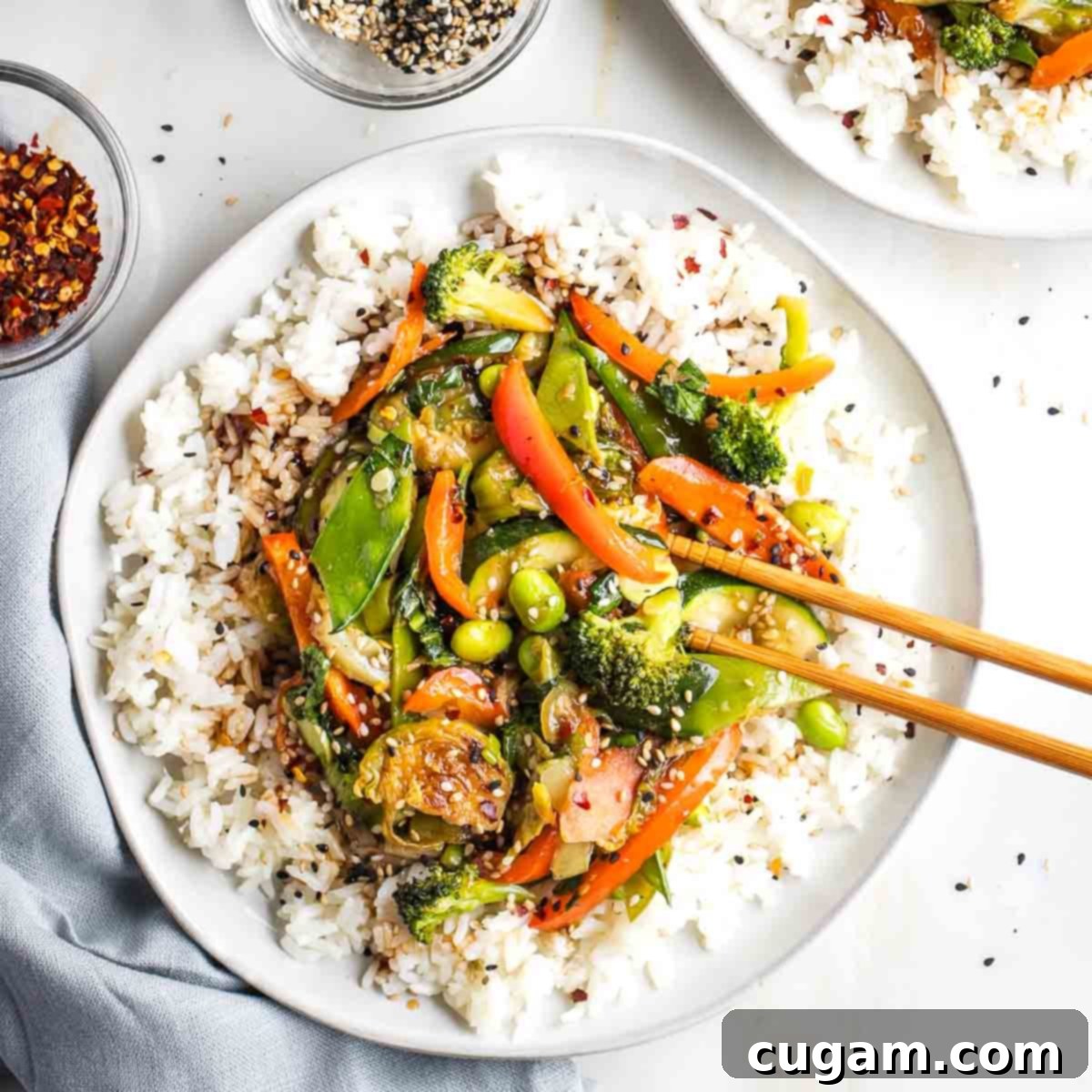Easy Teriyaki Vegetable Stir Fry: Healthy, Flavorful & Quick Homemade Recipe
Discover the ultimate weeknight meal with this incredibly simple yet profoundly delicious Teriyaki Stir Fry Vegetables Recipe. Forget the takeout; this homemade version is superior in every aspect – it’s tastier, more budget-friendly, packed with nutrition, and remarkably, ready in under 30 minutes! These Vegan Stir Fry Veggies with a luscious homemade Teriyaki Sauce are not only a breeze to prepare but also incredibly satisfying, making them ideal for a busy weeknight dinner or a vibrant, flavorful side dish.
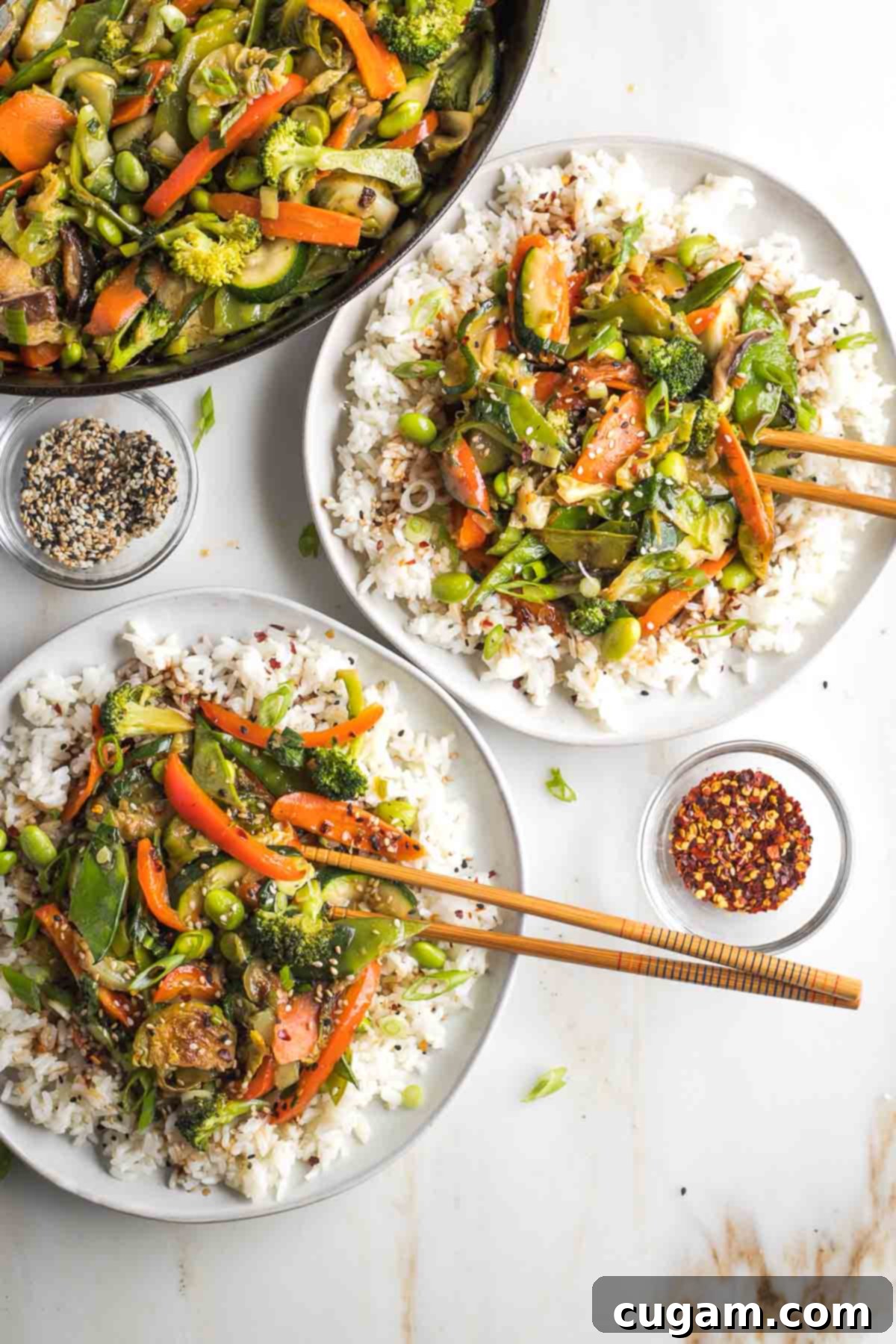
Why This Easy Teriyaki Stir Fry Will Become Your New Favorite
This teriyaki vegetable stir fry isn’t just a recipe; it’s a solution to those demanding evenings when you need a quick, healthy, and delicious meal without a lot of fuss. Here’s why it’s bound to become a staple in your kitchen:
- The Ultimate Dinner Solution: When you’re staring into the fridge with no plan, and the inevitable “What’s for dinner?” question arises, this stir fry is your answer. It’s so versatile and quick, it takes the stress out of mealtime.
- Flexible with Ingredients: Whether your pantry is stocked with fresh produce or your freezer holds a treasure trove of frozen vegetables, this recipe adapts. Use whatever you have on hand, ensuring minimal waste and maximum convenience.
- Customizable to Your Taste: This recipe is designed to work with YOUR favorite vegetables. Don’t like Brussels sprouts? Swap them for bell peppers! Love mushrooms? Add extra! The possibilities are endless, allowing you to tailor it to your dietary preferences and what’s in season.
- Delicious and Deeply Satisfying: With its savory, sweet, and slightly tangy homemade teriyaki sauce, these teriyaki vegetables are incredibly flavorful and remarkably satisfying. You won’t miss the meat in this vibrant, plant-based dish.
- Lightning-Fast Preparation: From start to finish, this meal is on your table in under 30 minutes. This makes it an absolute lifesaver for busy weeknights when time is precious.
- Healthier Homemade Sauce: By making your own teriyaki sauce from scratch, you gain complete control over the ingredients. This means you can avoid excessive sodium, refined sugars, and artificial additives often found in store-bought varieties, ensuring a much healthier and fresher taste.
- Perfect for Busy Lifestyles: Its quick preparation time and simple steps make it an amazing dinner option for anyone with a packed schedule who still wants to enjoy wholesome, flavorful food at home.
Crafting Your Own Irresistible Vegan Teriyaki Sauce
Creating your own teriyaki sauce isn’t just easy; it’s a game-changer for your stir fry. Compared to most store-bought options, this homemade version is significantly less expensive, bursts with fresher flavor, and is inherently healthier as you control every ingredient. Say goodbye to high-fructose corn syrup and preservatives!
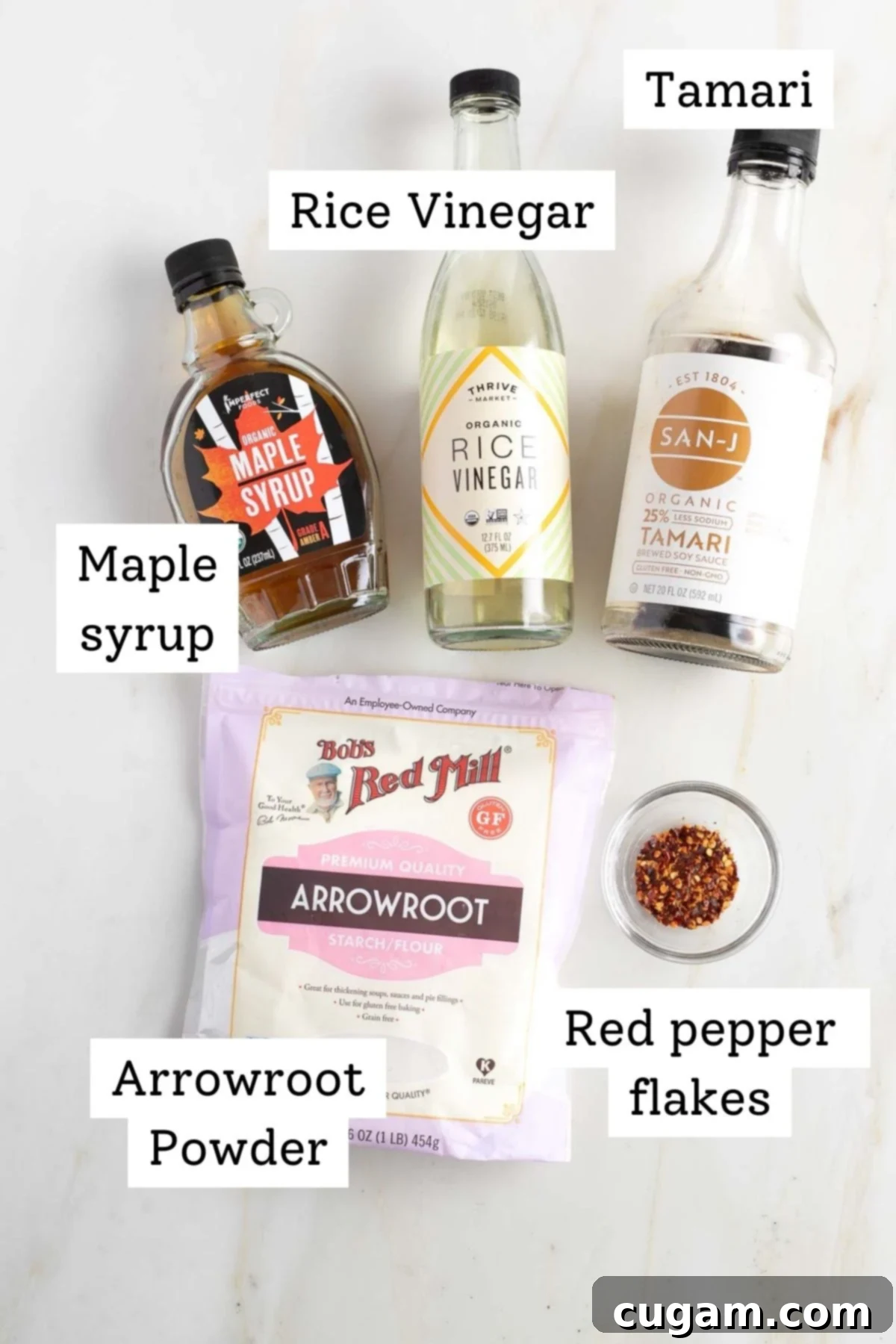
- Tamari: This is our preferred gluten-free alternative to traditional soy sauce, offering a similar rich, umami flavor with a slightly milder profile. Opt for a reduced-sodium variety whenever possible to keep the salt content in check, allowing the other flavors to shine. If gluten isn’t a concern, regular low-sodium soy sauce works perfectly too.
- Rice Vinegar: Unsweetened rice wine vinegar is crucial for balancing the sweetness of the maple syrup and the savory depth of the tamari. Its mild acidity brightens the sauce and adds an authentic Asian flavor. If you don’t have it, white vinegar, white wine vinegar, or even a squeeze of fresh lemon juice can be used as a substitute, though the flavor profile will vary slightly.
- Maple Syrup: We choose maple syrup as a natural, healthier sweetener, replacing the brown sugar or corn syrup often found in conventional stir fry recipes. It imparts a subtle caramel note that complements the other ingredients beautifully. Agave nectar or a small amount of coconut sugar can also be used.
- Arrowroot Powder: This is one of the best ways to naturally thicken your sauce, providing a glossy, smooth consistency without the cloudiness or potential for grittiness that cornstarch can sometimes cause. It’s also a great gluten-free option.
- Red Pepper Flakes: A pinch of red pepper flakes adds a fantastic subtle warmth and a hint of spice, elevating the overall flavor. If you prefer a bolder kick, feel free to add more or include a squirt of sriracha sauce for an extra fiery dimension.
Fresh vs. Frozen: The Great Vegetable Debate for Stir Fries
One of the true beauties and most convenient aspects of making a stir fry is the incredible flexibility it offers when it comes to vegetables. You are absolutely free to use either fresh or frozen veggies, and both options yield fantastic results. There’s no need to stress about having a perfectly stocked produce drawer!
In fact, a bag of high-quality frozen vegetables – where the veggies themselves are the only ingredients listed – can often be fresher and more nutritious than their “fresh” counterparts found in the supermarket. This is because frozen vegetables are typically flash-frozen at the peak of their ripeness, locking in nutrients and flavor. Fresh produce, on the other hand, can lose nutritional value during transportation and storage.
We understand that not everybody has the schedule flexibility to make a mid-week trip to the grocery store to replenish fresh produce. This is where frozen vegetable medleys truly shine! You can effortlessly keep a variety of chopped veggies in your freezer, ready to transform into a simple teriyaki stir fry on any given night. They come in many assortments and are incredibly convenient, providing a quick and easy way to get a wholesome dinner on the table without extra prep work. For the best results with frozen veggies, ensure there’s no freezer burn or large clumps of ice, and always add them directly from the freezer to the hot pan.
Essential Vegetable Stir Fry Ingredients & Customization Tips
The heart of any good stir fry is its vibrant array of vegetables. This recipe calls for a total of 5 cups of chopped vegetables, but feel free to mix and match based on your preferences and what’s available. The key is a good balance of textures and colors.
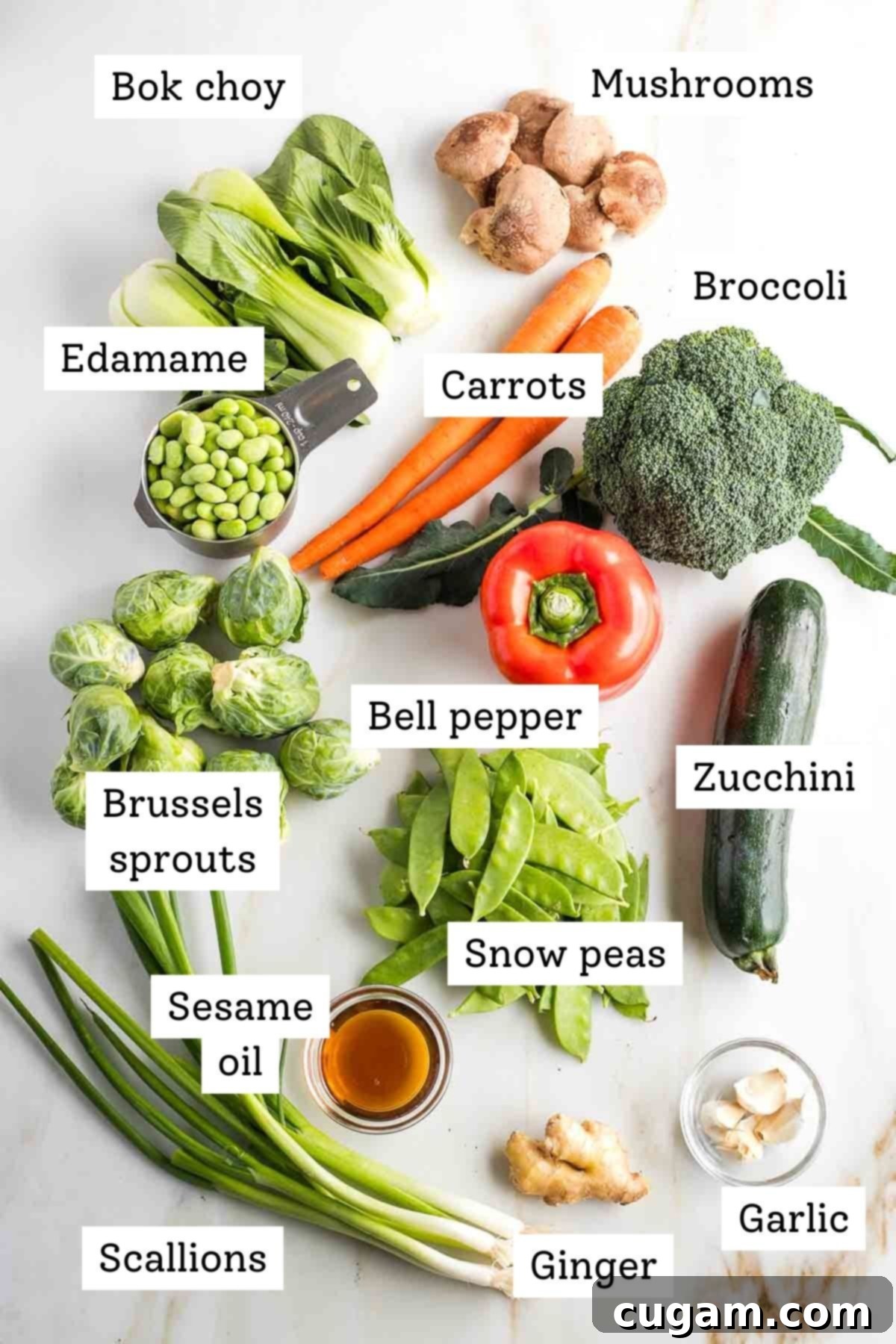
- Vegetables: For my stir fry, I used a delightful mix of broccoli, bok choy, shiitake mushrooms, crisp snow peas, vibrant red bell pepper, tender zucchini, earthy Brussels sprouts, and sweet carrots. This combination offers a variety of textures and nutrients. Other fantastic additions include snap peas, green beans, cauliflower florets, asparagus, or even sliced cabbage. A good rule of thumb is to use a combination of “harder” vegetables (like carrots, broccoli stems, Brussels sprouts) that take longer to cook, along with “softer” ones (like mushrooms, bell peppers, zucchini, leafy greens) that cook more quickly. This ensures everything is perfectly crisp-tender.
- Edamame: Shelled edamame beans are an excellent addition for a boost of plant-based protein, making this meal even more satisfying. They can be added directly from the freezer, making them incredibly convenient.
- Scallions: Also known as green onions, scallions add a mild oniony flavor and a fresh, bright garnish. If you don’t have scallions, thinly sliced red onion, leeks, or spring onions can be used as a suitable substitute.
- Garlic: Freshly minced or grated garlic provides a pungent, aromatic foundation for the stir fry. While fresh is always best for flavor, if you’re in a pinch, garlic powder can be used (approximately ¼ teaspoon of garlic powder per clove of fresh garlic), but avoid garlic salt, which will make your dish too salty.
- Ginger: Nothing quite compares to the zesty, warming flavor of freshly grated ginger. It’s a signature ingredient in Asian cooking and truly elevates this stir fry. Use a microplane for the finest texture and maximum flavor release.
- Oil: I prefer toasted sesame oil for its distinct, nutty aroma that complements the teriyaki sauce beautifully. If you’re not a fan of toasted sesame oil, or if you prefer a milder flavor, regular sesame oil, avocado oil, or a neutral high-heat oil like grapeseed oil can be used. A combination of one of these with a touch of olive oil also works. For an oil-free stir fry, you can use vegetable broth as a cooking liquid instead of oil.
- Optional Garnishes and Add-ins: Once your teriyaki vegetable stir fry is cooked, sprinkle it with sesame seeds for added crunch and visual appeal. Additional sliced scallions bring a fresh finish, and a sprinkle of crushed red pepper offers an extra kick. For more texture and freshness, toss in some bean sprouts just before serving.
Mastering the Art of the Stir Fry: A Step-by-Step Guide
The key to a successful stir fry is preparation, often referred to as “mise en place.” Make sure all your fresh vegetables are thoroughly washed, dried, and chopped into uniform bite-sized pieces before you even turn on the heat. This ensures even cooking and a stress-free stir-frying experience. If you’re using frozen veggies, you can simply take them straight from the freezer to the pan; no thawing necessary!
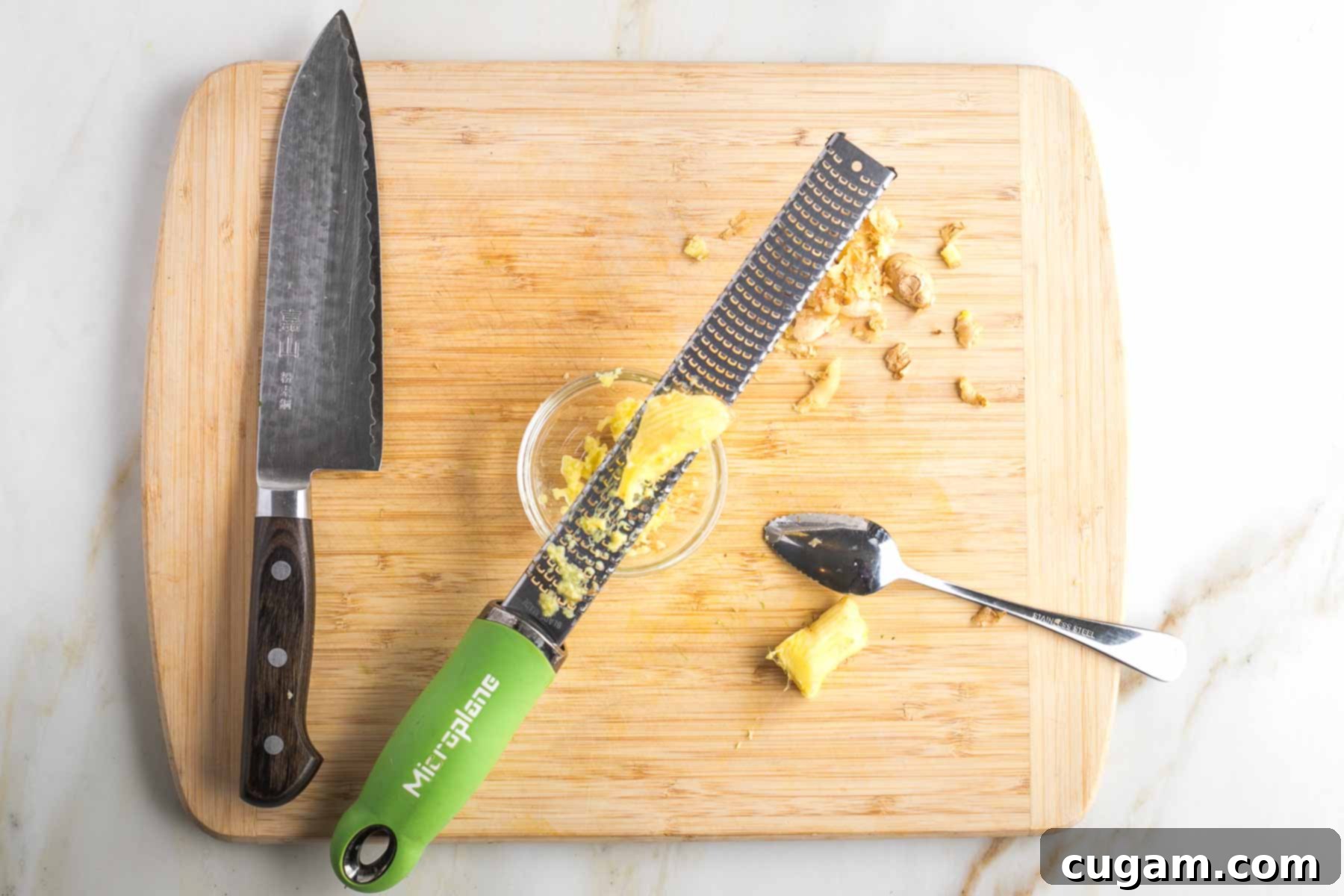
For peeling fresh ginger, a grapefruit spoon works wonderfully for gently scraping off the thin skin. Then, use a microplane to grate it finely, releasing maximum flavor. Alternatively, a sharp knife can be used to peel and finely mince the ginger.
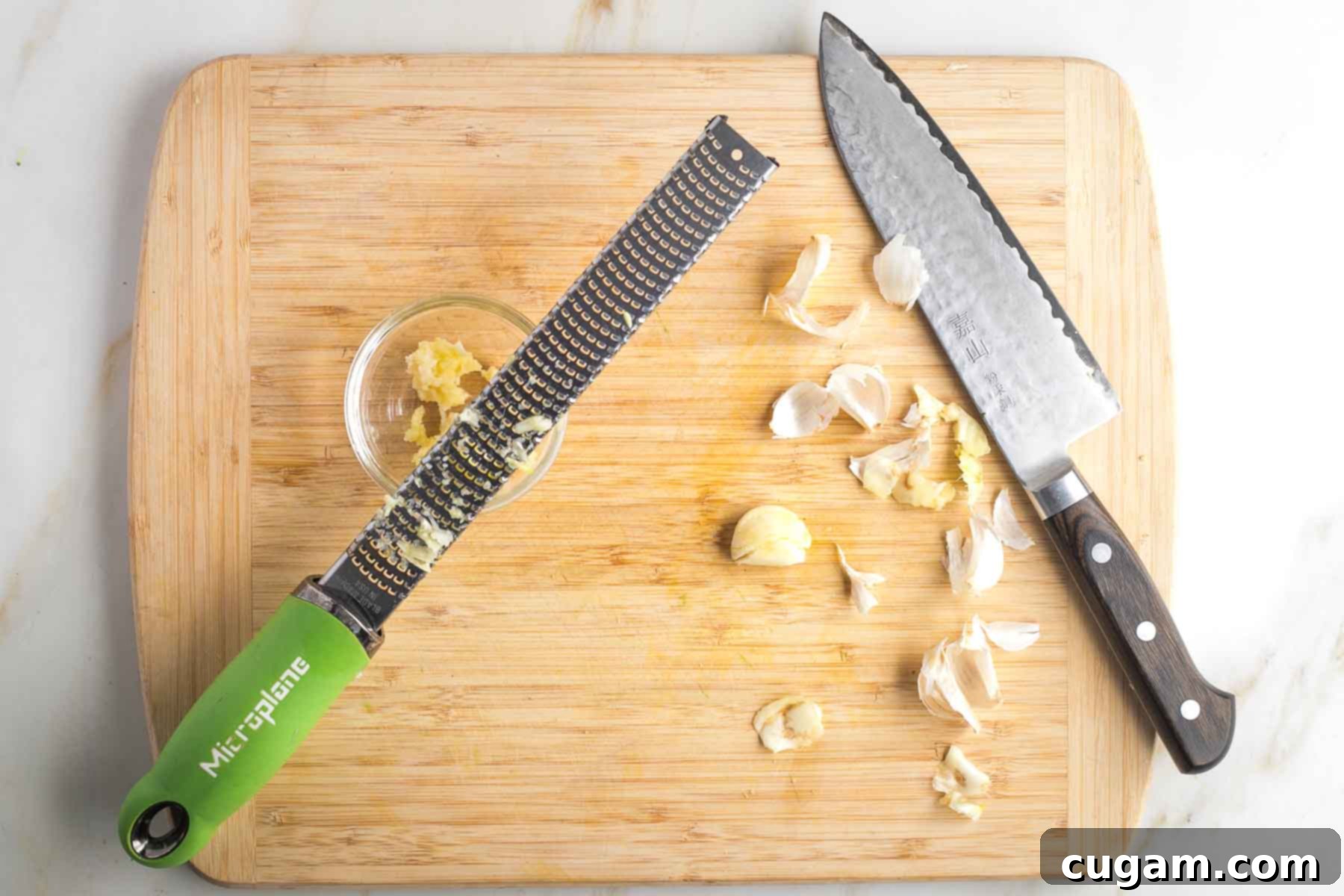
Similarly, peel your garlic cloves and grate them on the microplane for a fine, uniform texture that melts into the sauce. If a microplane isn’t available, you can easily press the garlic with a garlic press or finely mince it with a knife.
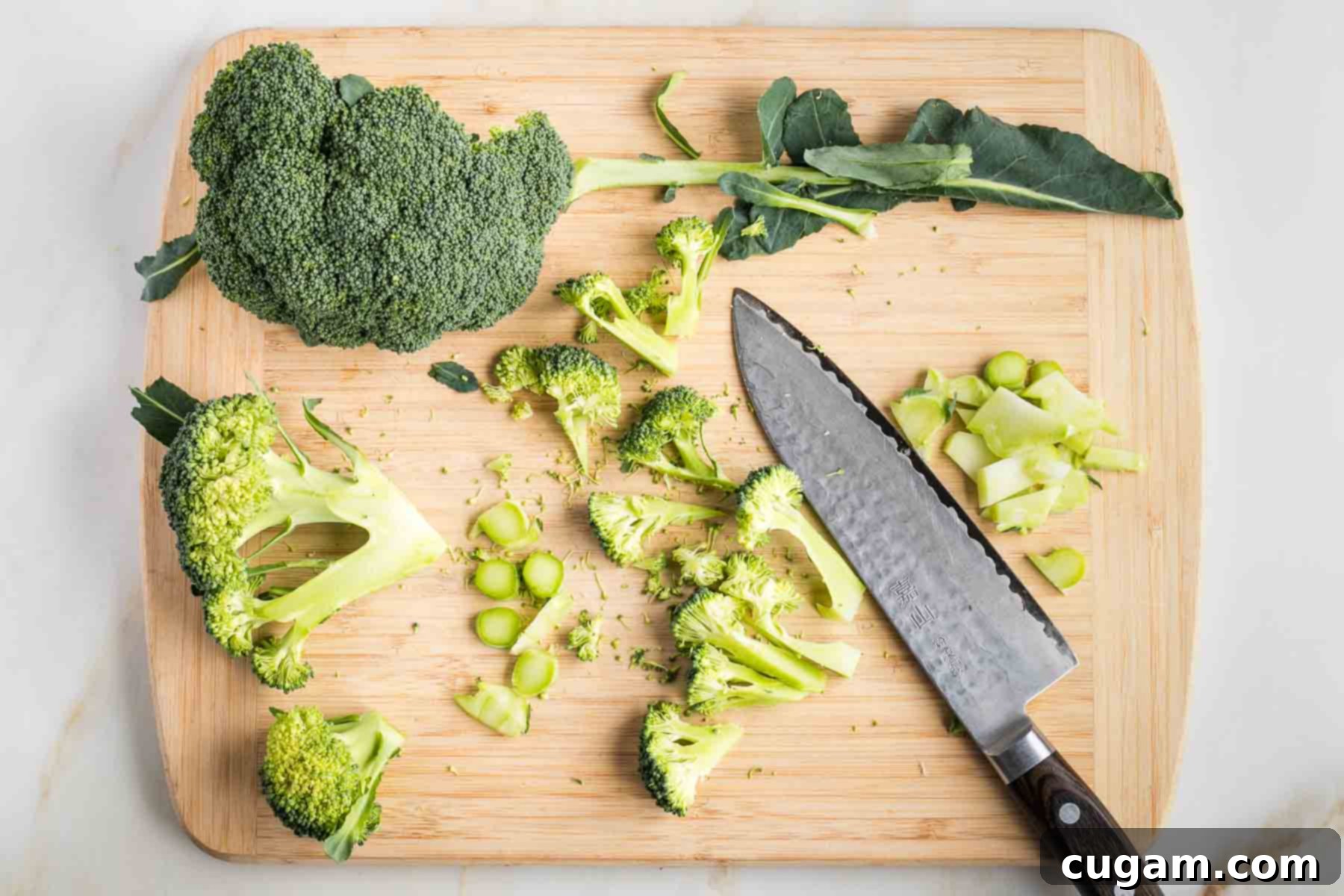
Ensure each vegetable is chopped into uniform, bite-sized pieces. For broccoli, utilize both the florets and the stems! Cut the tougher stems into thin discs, which will cook similarly to the florets, minimizing waste and adding extra texture.
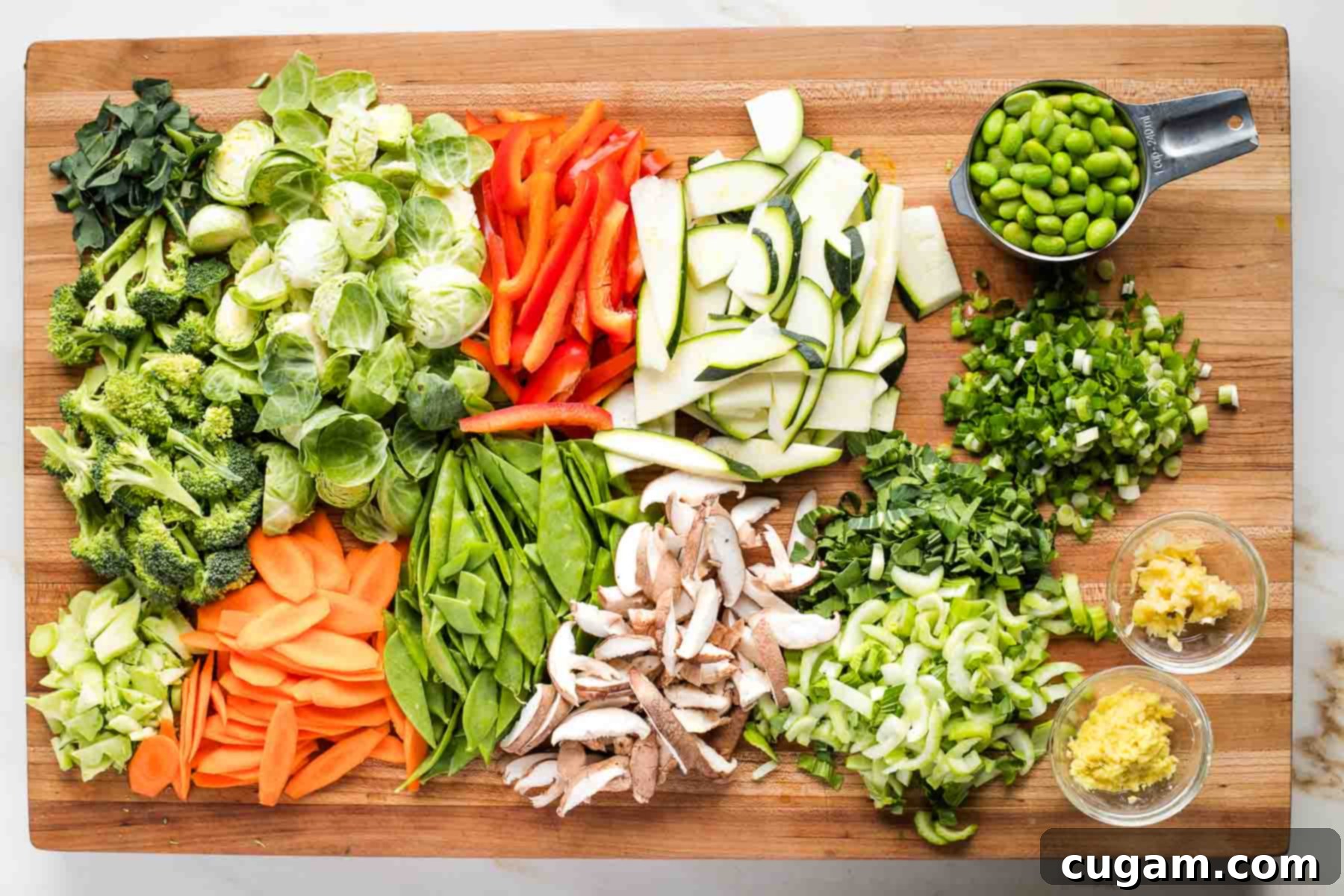
Organize your prepped vegetables close to your stove in the order they will enter the pan. Harder vegetables that require more cooking time, such as carrots, broccoli stems, and Brussels sprouts, will go in first. Softer vegetables like mushrooms and bell peppers will follow.
Step 1: Make the Teriyaki Sauce
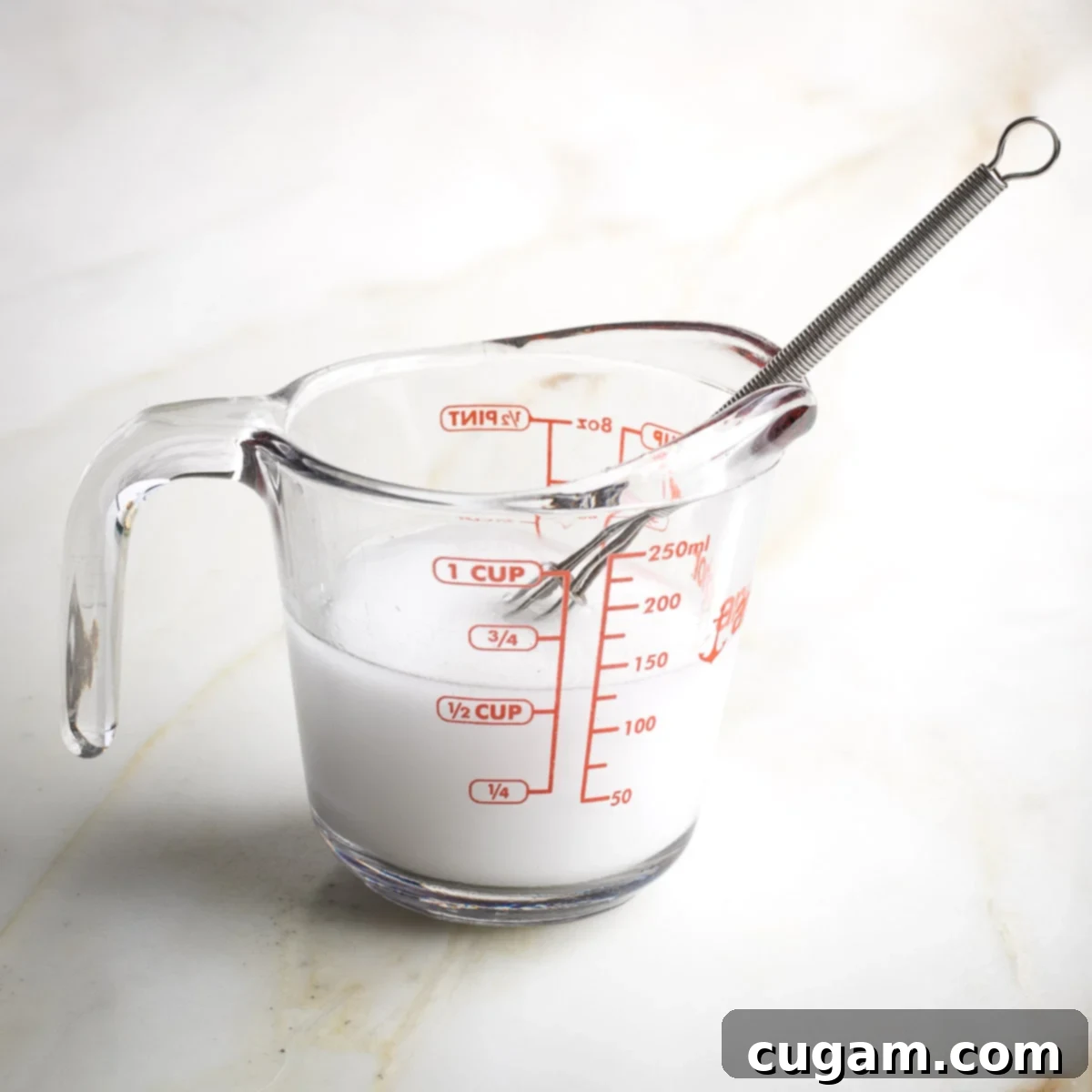
Begin by creating your arrowroot slurry: whisk the arrowroot powder with ½ cup of cold water until completely smooth. In a small saucepan, combine the tamari, maple syrup, and rice vinegar over medium heat. Once it starts to warm, whisk in the arrowroot slurry and the red pepper flakes. Continue to whisk constantly as the sauce comes to a gentle boil. Reduce the heat and keep whisking for about 3 minutes until it visibly begins to thicken and coats the back of a spoon. Turn off the heat and remove from the stove. The sauce will continue to thicken and develop a beautiful sheen as it cools. Set it aside while you prepare your vegetables.
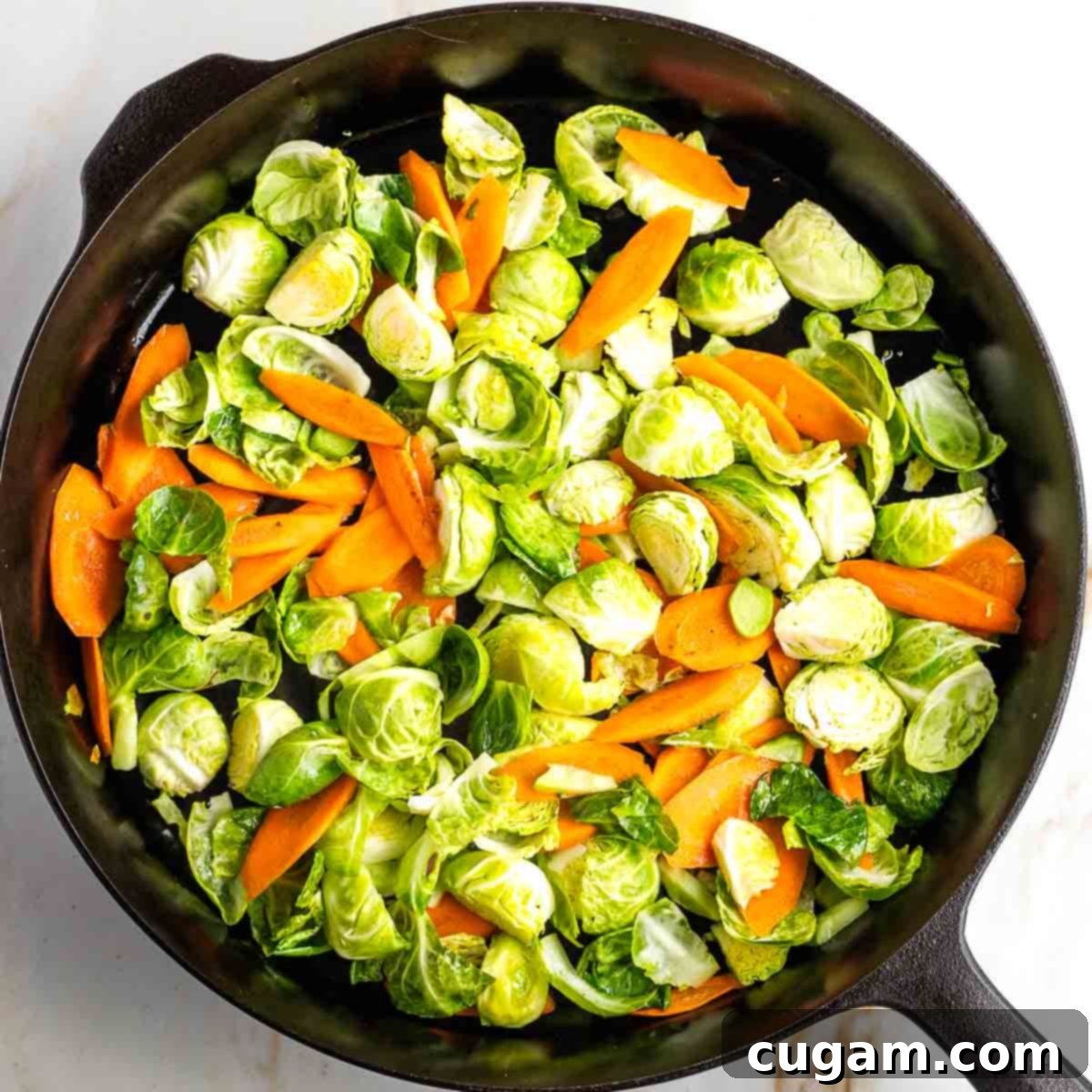
Heat a large wok or your largest frying pan over high heat until very hot. Swirl in half of the toasted sesame oil. Add your harder vegetables first: the carrots, Brussels sprouts, and broccoli stems. Using tongs, toss and stir-fry these vigorously for about 2 minutes. The goal is a quick sear and tender-crisp texture.
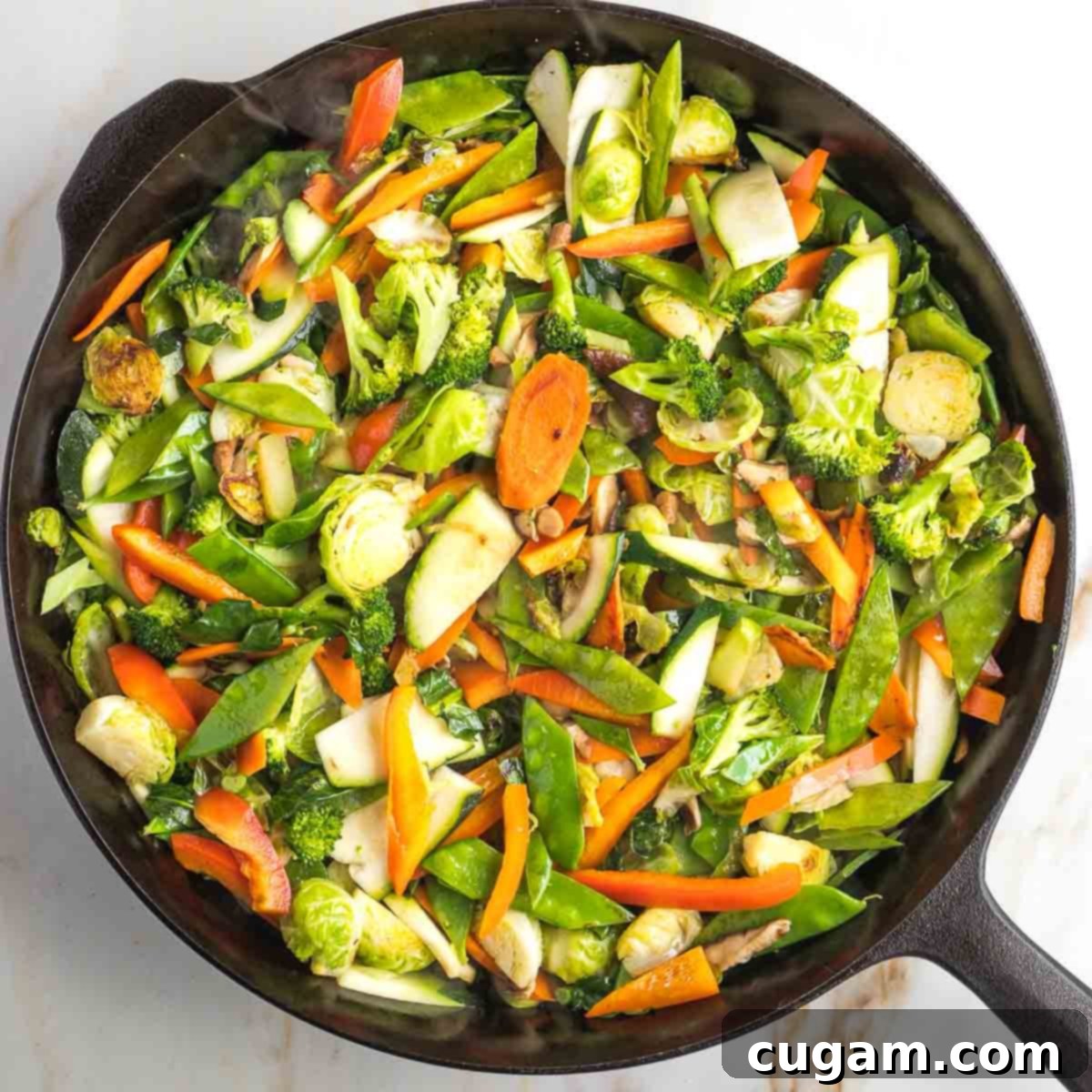
Reduce the heat to medium-high. Add the remaining vegetables: broccoli florets, sliced mushrooms, bell pepper strips, bok choy, and snow peas. Continue to cook and toss for another 3-4 minutes, until all the vegetables are tender-crisp but still retain a slight bite. Avoid overcooking to maintain their vibrant color and texture.
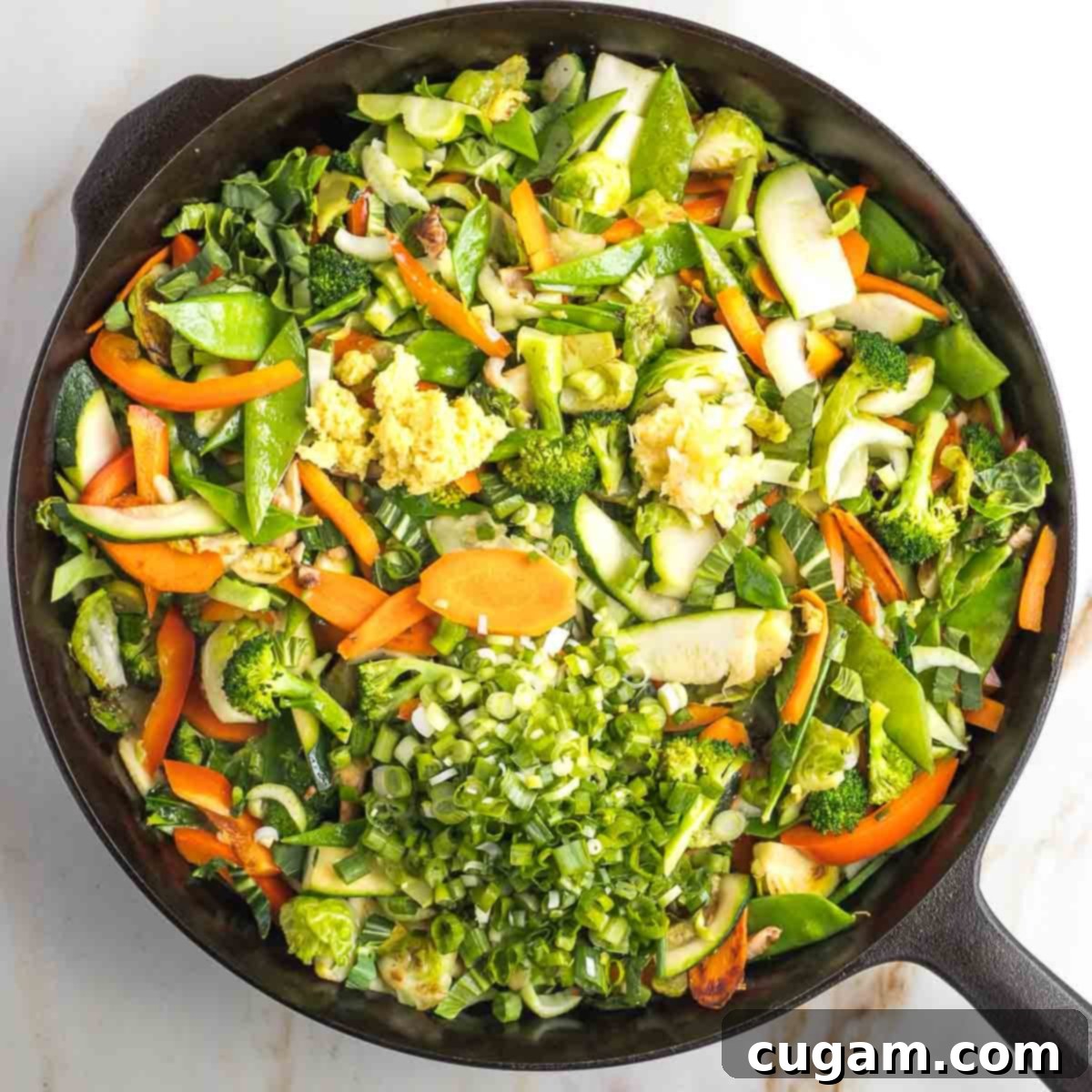
Now it’s time for the aromatics! Add the minced garlic, grated ginger, thinly sliced scallions, and the remaining sesame oil to the pan. These ingredients will infuse the stir fry with incredible fragrance and depth of flavor.
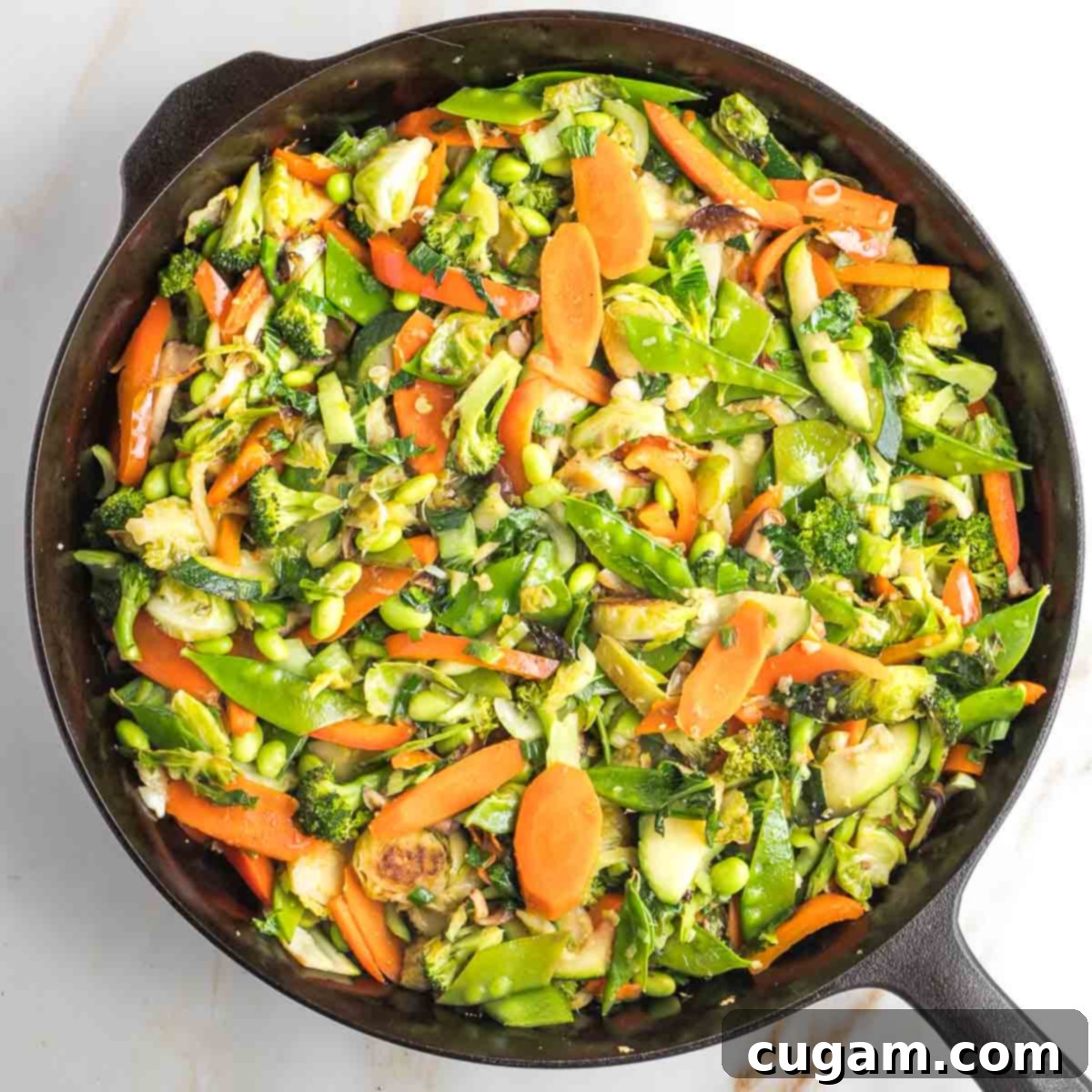
Stir and cook for about 1 minute until the aromatics are fragrant, being very careful not to burn the garlic. Keep everything moving in the pan to evenly distribute these delicate flavors without scorching them. Turn off the heat.
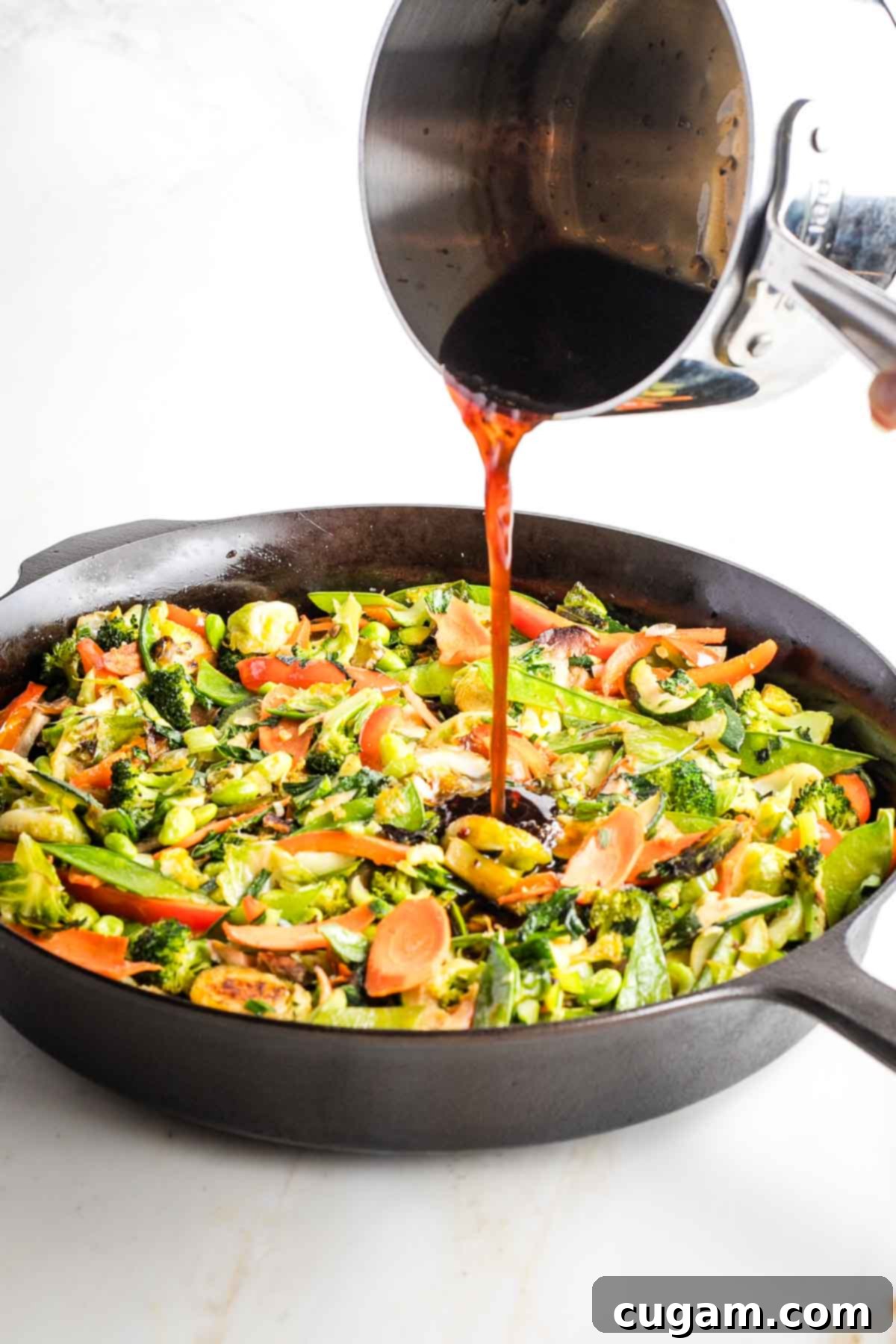
Before adding, quickly reheat the teriyaki sauce on the stove if it has cooled and give it a vigorous whisk to ensure it’s smooth and ready. Then, pour about half of the prepared sauce directly over the hot, finished vegetables in the pan.
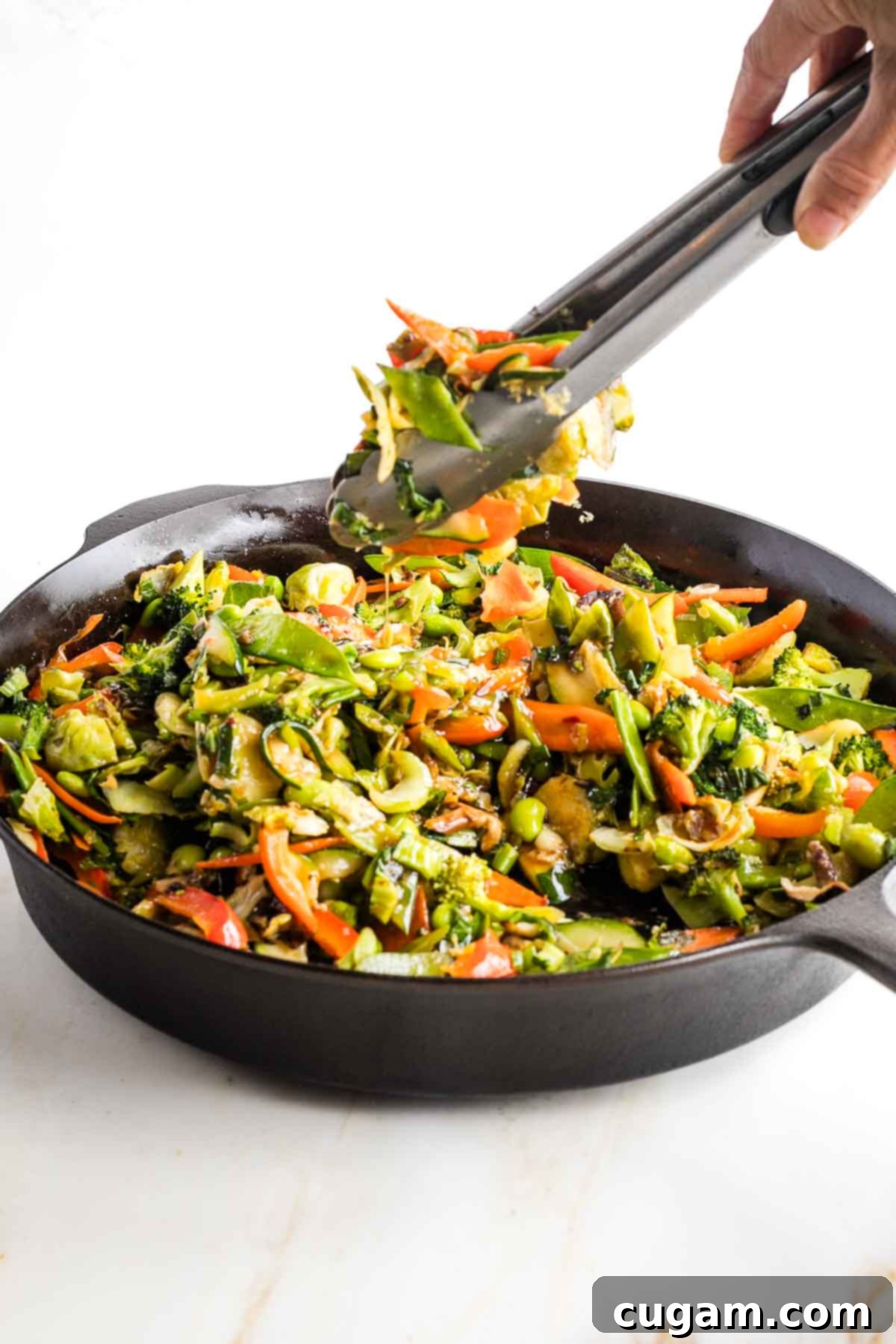
Use your tongs to thoroughly mix the sauce into the vegetables, tossing until every piece is beautifully coated. Add additional sauce as needed, to your desired sauciness, ensuring it is fully incorporated. Serve immediately!
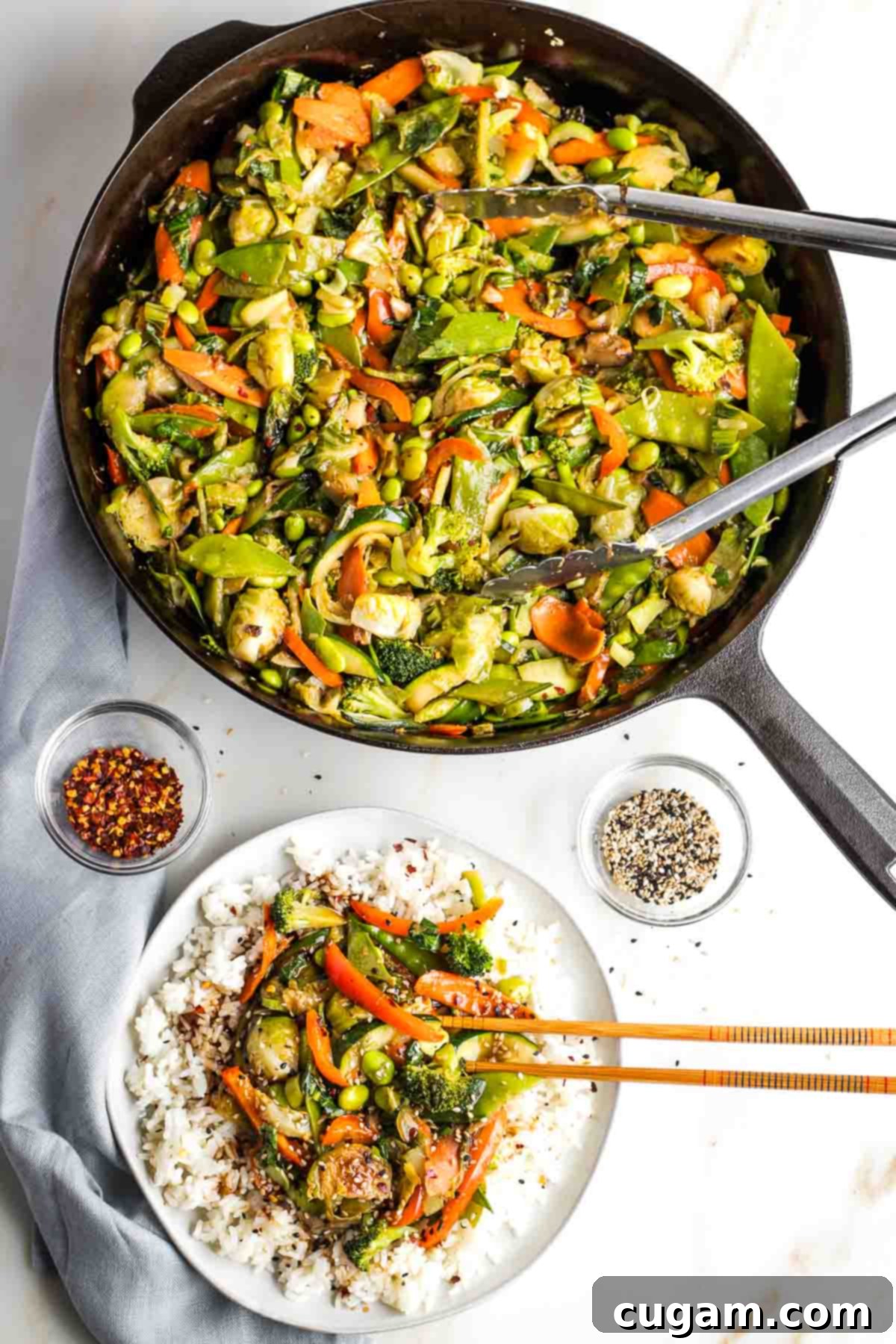
For a perfect presentation and added flavor, sprinkle your finished teriyaki vegetable stir fry generously with sesame seeds, a pinch of crushed red pepper for extra heat, and any additional sauce you desire. Enjoy this vibrant and healthy meal!
Perfect Pairings: What to Serve with Your Teriyaki Vegetables
This versatile teriyaki vegetable stir fry can be the star of your meal or a fantastic supporting act. Here are some delicious ideas for what to serve alongside it:
- Crispy Baked Tofu: For a complete and protein-packed vegan meal, serving your stir fry over or alongside perfectly crispy baked tofu is a match made in heaven. The tofu absorbs the teriyaki flavors beautifully.
- Ginger Miso Slaw: A refreshing and crunchy side salad with an Asian-inspired dressing can provide a wonderful contrast in texture and flavor to the warm stir fry.
- Brown Rice or White Rice: Classic choices that provide a neutral base to soak up all the delicious teriyaki sauce. Brown rice adds a nutty flavor and extra fiber, while white rice offers a lighter texture.
- Simple Cauliflower Rice: For a low-carb or grain-free option, cauliflower rice is an excellent substitute that still allows you to enjoy all the flavors of your stir fry.
- Rice Noodles or Ramen Noodles: If you prefer noodles over rice, simply cook your favorite rice noodles or gluten-free ramen noodles according to package directions and toss them with the stir fry for a delightful noodle dish.
Debra’s Pro Tips for Stir-Frying Success
Elevate your stir-fry game with these expert tips:
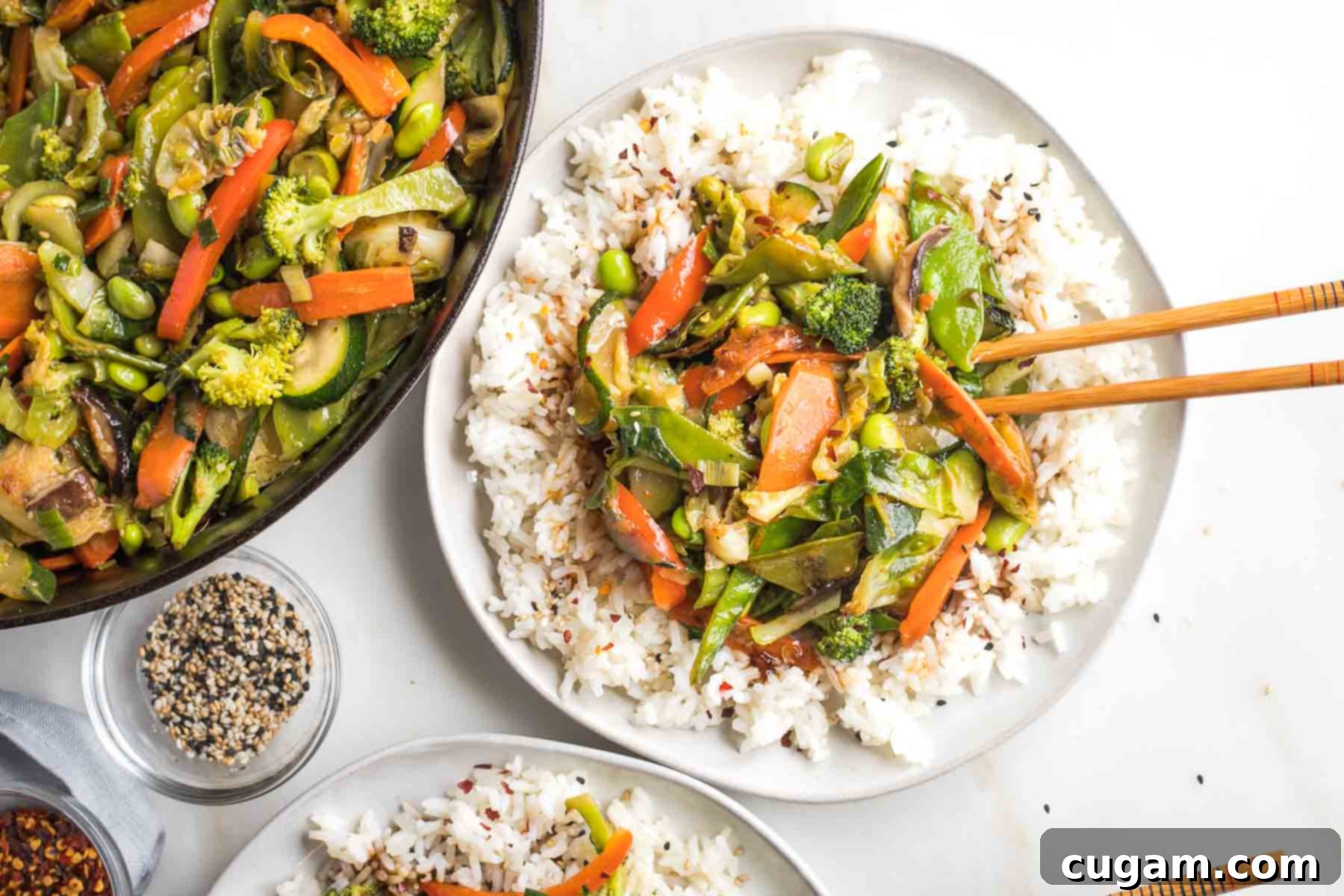
- Reheating Rice Perfectly: If you’re serving this delicious stir fry over rice and anticipate leftovers, here’s a smart trick: mix any remaining cooked rice directly with the veggies before storing them. This simple step prevents the rice from clumping and getting hard in the fridge, making it much easier and more enjoyable to reheat later.
- Layering Vegetables for Even Cooking: The secret to perfectly cooked, tender-crisp stir-fried vegetables lies in how you add them to the pan. Always start with the harder or thicker-cut vegetables first, as they require more time to cook through. Think carrots, broccoli stems, and Brussels sprouts. Then, gradually add softer, quicker-cooking vegetables like mushrooms, bell peppers, and leafy greens. Don’t stress too much about exact timings – it’s more about a logical sequence to ensure everything finishes cooking around the same time.
- Don’t Overcrowd the Pan: This is a crucial rule for stir-frying. If you add too many vegetables at once, the temperature of your pan will drop too quickly, causing the vegetables to steam instead of sear. This results in soggy, rather than crisp-tender, veggies. If you have a large batch of vegetables, cook them in two smaller batches.
- Use High Heat: Stir-frying demands high heat and constant movement. A very hot pan quickly sears the vegetables, locking in their flavors and nutrients while creating a delicious slightly charred exterior.
- Mise en Place is Key: As mentioned earlier, having all your ingredients chopped and ready to go before you start cooking is essential. Stir-frying is a very fast process, and you won’t have time to chop while the pan is hot.
Storage and Reheating Best Practices for Leftovers
Proper storage and reheating ensure your delicious teriyaki vegetable stir fry remains enjoyable for days to come:
- Storing Your Stir Fry: Store any leftover stir-fried vegetables in an airtight container in the refrigerator for up to 5 days. For any leftover homemade teriyaki sauce, store it separately in a sealed jar in the fridge for up to a week.
- Reheating for Optimal Flavor: To reheat, you have a couple of excellent options. You can warm the leftover veggies in a skillet over medium-high heat, stirring occasionally until they are heated through and regain some of their crispness. Alternatively, spread them on a baking sheet and reheat in a 375-degree Fahrenheit oven for about 15 minutes, or until thoroughly warmed.
- Freezing for Future Meals: The homemade teriyaki sauce freezes beautifully. Pour it into a freezer-safe jar, ensuring to leave enough headspace for expansion, and freeze for up to 3 months. Thaw in the refrigerator, give it a good shake, and it’s ready to use. While you can freeze the cooked vegetable teriyaki stir-fry in a freezer-safe container for up to 3 months, be aware that the texture of some vegetables (especially softer ones) might change slightly after thawing and reheating, becoming a bit softer. It will still be safe and delicious to consume, just with a different mouthfeel.
- Effortless Meal Prep: To make weeknights even easier, you can meal prep some components in advance. Chop all your fresh vegetables and store them in an airtight container in the fridge for 2-3 days until you’re ready to stir fry. The teriyaki sauce can also be made ahead of time and stored in a glass jar in the refrigerator for up to a week. This way, dinner comes together in mere minutes!
Did you know commenting and rating recipes is one of the best ways to support your favorite food bloggers? If you made this recipe, please consider leaving a five-star rating below and a comment sharing your experience. Also, we’d love to see your culinary creations! Please share your photos on Instagram by tagging me @dkhealthcoach and using the hashtag #debraklein. Your support means the world!
📖 Recipe

Teriyaki Stir Fry Vegetables
Debra Klein
Rate this Recipe
Pin Recipe
15 minutes
10 minutes
25 minutes
Main Course, Side Dish
Asian
4
204
kcal
Equipment
-
1 Wok
-
Chef’s knife
-
Extra Large Bamboo Cutting Board
-
Small Whisk
-
Pyrex Glass Measuring Cup Set
-
Microplane
Ingredients
Teriyaki Sauce
-
⅓
cup
Tamari -
3
tablespoon
unsweetened rice vinegar -
2
tablespoon
maple syrup -
1
tablespoon
arrowroot powder -
½
teaspoon
red pepper flakes
Stir Fry Ingredients
-
5
cups
chopped veggies -
1
cup
shelled edamame beans -
4
cloves
garlic
minced or grated -
2-inch
fresh ginger
peeled and grated or minced -
1
bunch
scallions
thinly sliced -
2
tablespoon
toasted sesame oil
Instructions
Teriyaki Sauce
-
Whisk together water and arrowroot powder to form a slurry. Heat tamari, vinegar and maple syrup in a small sauce pan over medium heat. Whisk in the arrowroot mixture and the red pepper flakes. Continue to whisk for about 3 minutes as the sauce thickens. Turn off heat and set aside until vegetables are finished.
Stir Fry
-
Prep ginger by peeling and mincing. Same with garlic. Thinly slice scallions. Cut all veggies into bite sized pieces.
-
Heat a large wok, or your largest frying pan over medium-high heat. Swirl in 1 tablespoon of the oil and start with your hardest veggies. For me, that was the carrots, broccoli stalks and quartered brussels sprouts. Use tongs to toss and continue for about 2 minutes.
-
Next, add the broccoli florets, red pepper strips, mushrooms, zucchini, snow peas. Continue to toss and cook until veggies are tender, but still al dente.
-
Add the scallions, ginger, garlic and remaining tablespoon oil. Reduce heat and stir constantly until fragrant and thoroughly mixed. Turn off heat.
-
Reheat the teriyaki sauce, giving it a quick whisk and then pour half onto the stir fry vegetables.
-
Sprinkle with sesame seeds and serve over rice or noodles.
Notes
- Fresh Vegetables: Cut into bite sized pieces, any combination of broccoli, cauliflower, zucchini, bell peppers, mushrooms, brussels sprouts, bok choy, carrots, snow peas, snap peas to equal 5 cups.
- Frozen Vegetables: Choose your favorite medley. Be sure there isn’t any freezer burn or clumps of ice on your frozen veggies. Use them straight from the freezer to the pan.
Nutrition Information: Actual nutrition information will vary depending on which vegetables you choose.
Optional: sprinkle with sesame seeds and more red pepper flakes, if desired.
Nutrition
Calories:
204
kcal
Carbohydrates:
22
g
Protein:
9
g
Fat:
10
g
Saturated Fat:
1
g
Polyunsaturated Fat:
3
g
Monounsaturated Fat:
4
g
Sodium:
1123
mg
Potassium:
600
mg
Fiber:
5
g
Sugar:
9
g
Vitamin A:
819
IU
Vitamin C:
99
mg
Calcium:
104
mg
Iron:
2
mg
Note
The nutrition calculations were done using online tools. To obtain the most accurate representation of the nutritional information in any given recipe, you should calculate the nutritional information with the actual ingredients you used. You are ultimately responsible for ensuring that any nutritional information is accurate, complete and useful.
Did you make this recipe?
Please leave a review below, then snap a picture and tag me @dkhealthcoach or use hashtag #dkhealtcoach on Instagram so I can see it!!
